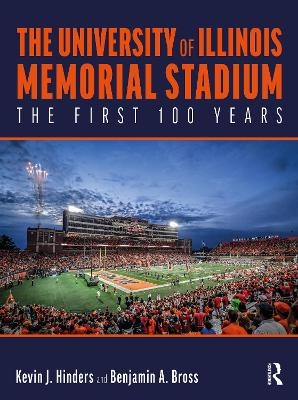
The University of Illinois Memorial Stadium
The First 100 Years
Seiten
2024
Routledge (Verlag)
978-1-032-64384-7 (ISBN)
Routledge (Verlag)
978-1-032-64384-7 (ISBN)
This book offers a rigorous but graphically compelling narrative historic analysis of one of the most important civic buildings not only of the University of Illinois Urbana-Champaign, or the State of Illinois, but arguably of the United States, Memorial Stadium.
Like all spatial products, the design and construction of the University of Illinois Memorial Stadium embodies the social, political, economic, aspiration, and aesthetic values of its time. This book will engage in critical analysis including documenting the civic discourse that led to the Stadium and thereafter explore the iterative nature of the Stadium in shaping civic discourse. In this vein, central topics include its role in embodying the state’s economic growth; the changing nature of the sociocultural tendencies and its impact on campus life and the University’s community; the Stadium’s effects on UIUC sports and the campus’ built environment; the rise of College sports as big business; and the impact on mass culture across the State and the country, like the use of stadiums as concert venues and place of public discourse. More than a simple study of the building’s conceptualization, design, and construction, this book reveals why Illinois’ Memorial Stadium is an iconic part of the American Midwest’s built landscape and in many ways part of the American mythic landscape.
This will be interesting reading for all those familiar with the building, as well as all students and scholars of sports architecture.
Like all spatial products, the design and construction of the University of Illinois Memorial Stadium embodies the social, political, economic, aspiration, and aesthetic values of its time. This book will engage in critical analysis including documenting the civic discourse that led to the Stadium and thereafter explore the iterative nature of the Stadium in shaping civic discourse. In this vein, central topics include its role in embodying the state’s economic growth; the changing nature of the sociocultural tendencies and its impact on campus life and the University’s community; the Stadium’s effects on UIUC sports and the campus’ built environment; the rise of College sports as big business; and the impact on mass culture across the State and the country, like the use of stadiums as concert venues and place of public discourse. More than a simple study of the building’s conceptualization, design, and construction, this book reveals why Illinois’ Memorial Stadium is an iconic part of the American Midwest’s built landscape and in many ways part of the American mythic landscape.
This will be interesting reading for all those familiar with the building, as well as all students and scholars of sports architecture.
Kevin J. Hinders is an Associate Professor of Architecture and director of the Chicago Studio at the University of Illinois, Urbana-Champaign. Benjamin A. Bross is an Assistant Professor of Architecture at the University of Illinois, Urbana-Champaign.
Introduction 1. Founding the University of Illinois 2. Origins of Memorial Stadium 3. Memorial Stadium’s Design and Construction 4. Building Memorial Stadium 5. Memorial Stadium, 1924−1941 6. From World War II to 1960 7. The Tumultuous Years, 1960 to 1975 8. A New Stadium Era 9. The New Millennium 10. The Point After
| Erscheinungsdatum | 30.10.2024 |
|---|---|
| Zusatzinfo | 1 Line drawings, color; 226 Halftones, color; 227 Illustrations, color |
| Verlagsort | London |
| Sprache | englisch |
| Maße | 210 x 280 mm |
| Gewicht | 1433 g |
| Themenwelt | Naturwissenschaften ► Biologie ► Ökologie / Naturschutz |
| Naturwissenschaften ► Geowissenschaften ► Geografie / Kartografie | |
| Sozialwissenschaften ► Soziologie ► Spezielle Soziologien | |
| Technik ► Architektur | |
| Weitere Fachgebiete ► Sportwissenschaft | |
| ISBN-10 | 1-032-64384-6 / 1032643846 |
| ISBN-13 | 978-1-032-64384-7 / 9781032643847 |
| Zustand | Neuware |
| Informationen gemäß Produktsicherheitsverordnung (GPSR) | |
| Haben Sie eine Frage zum Produkt? |
Mehr entdecken
aus dem Bereich
aus dem Bereich
Planung · Recht · Verfahren
Buch | Hardcover (2024)
Springer Vieweg (Verlag)
64,99 €


